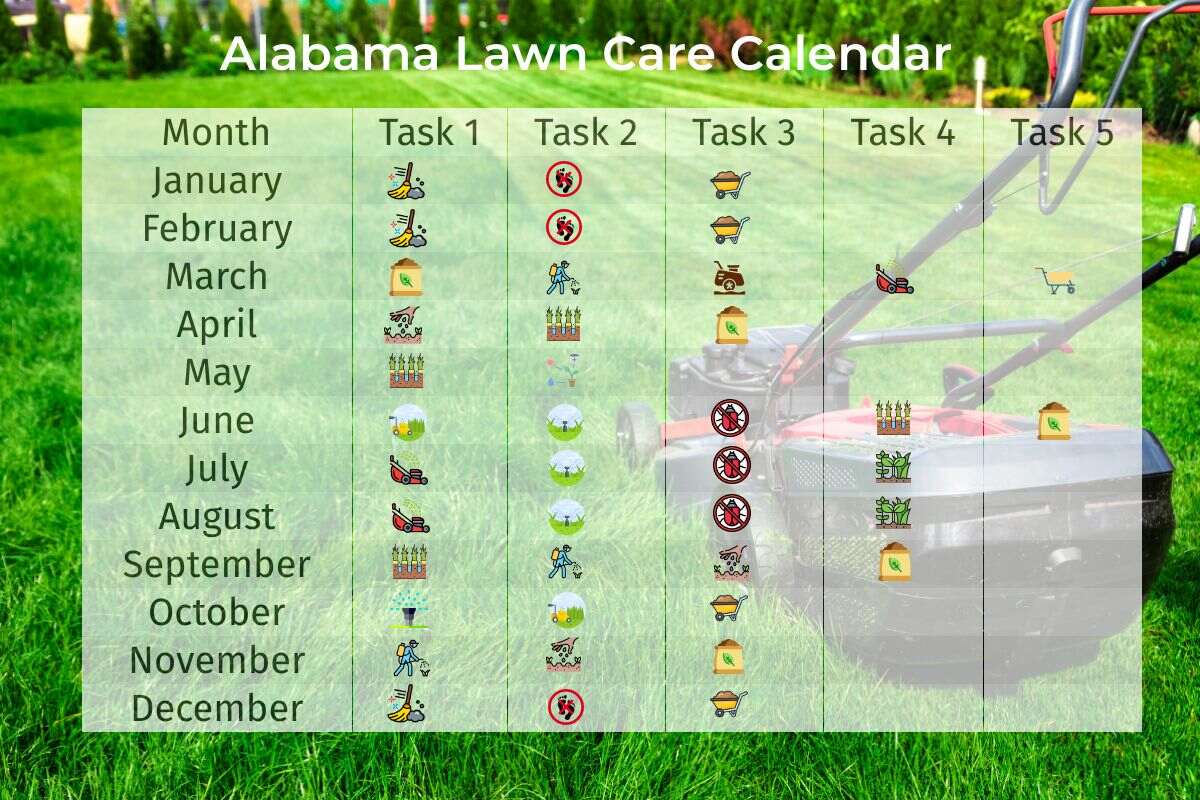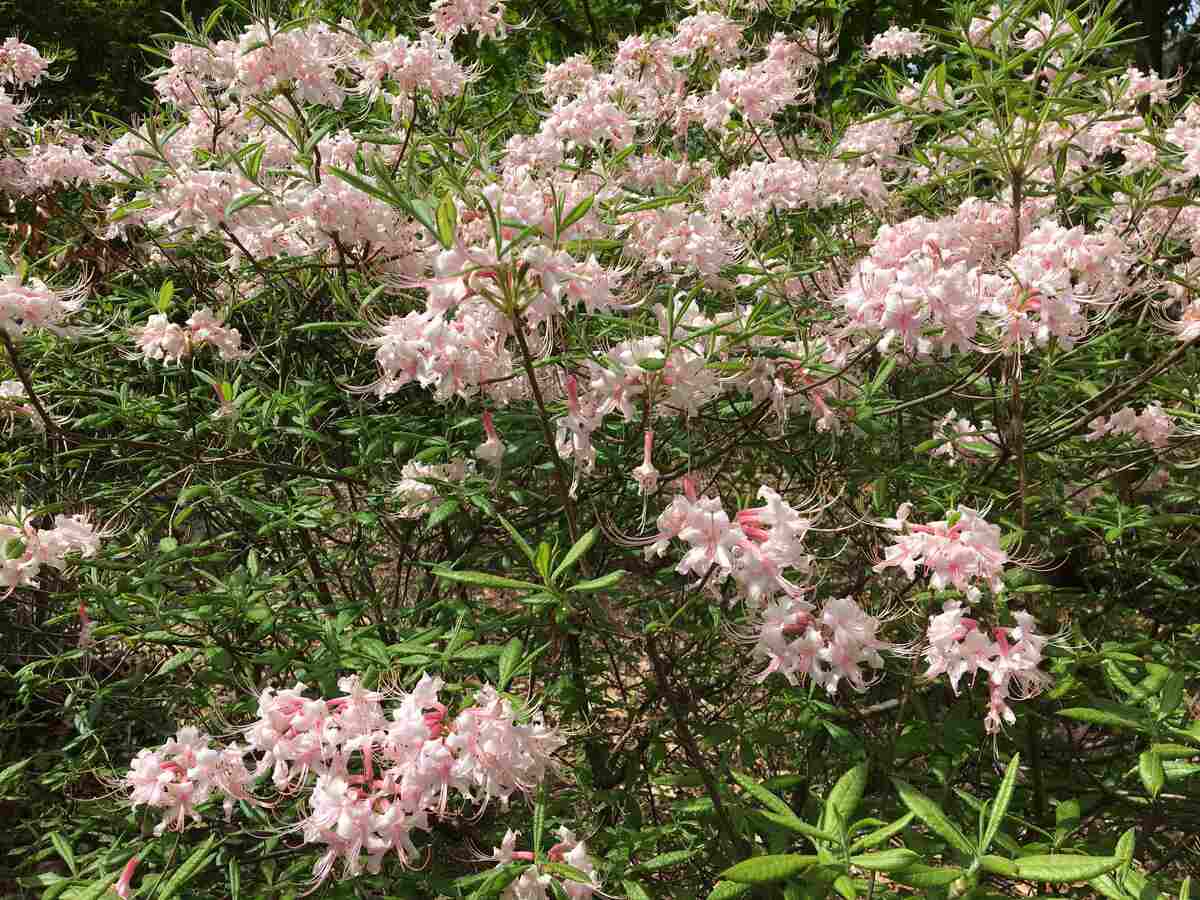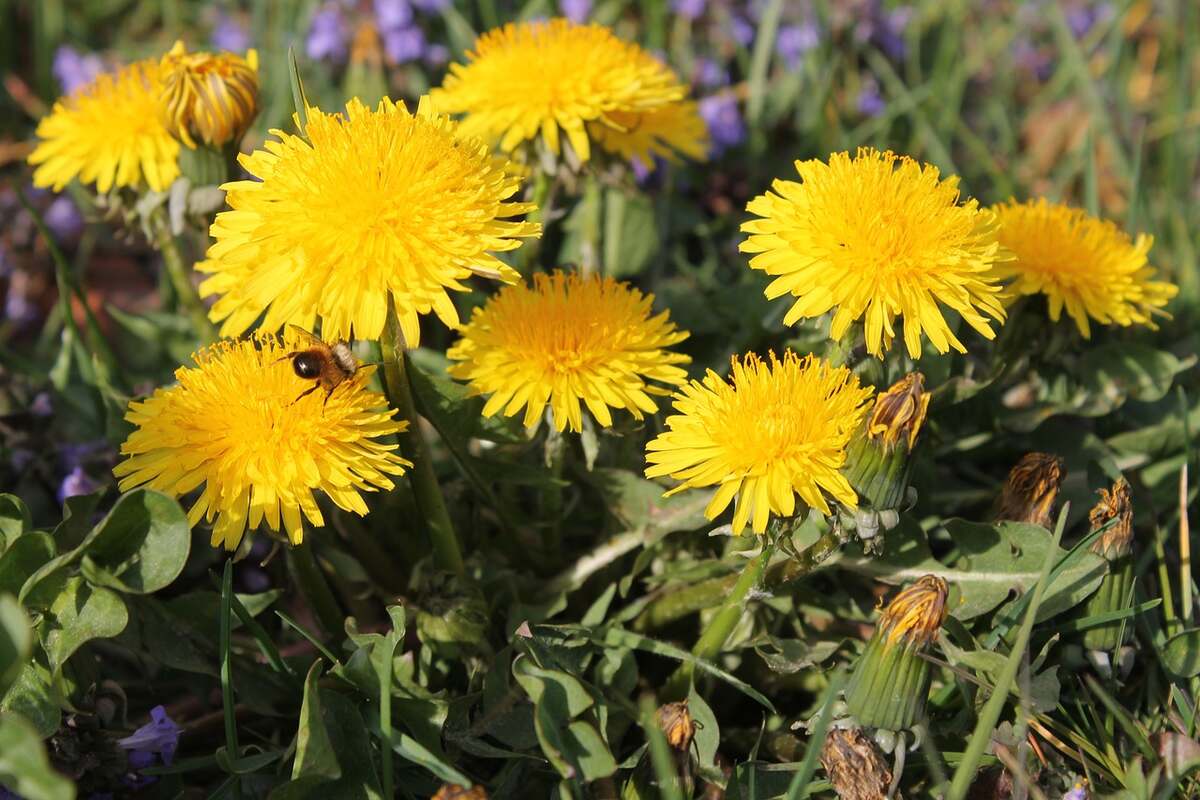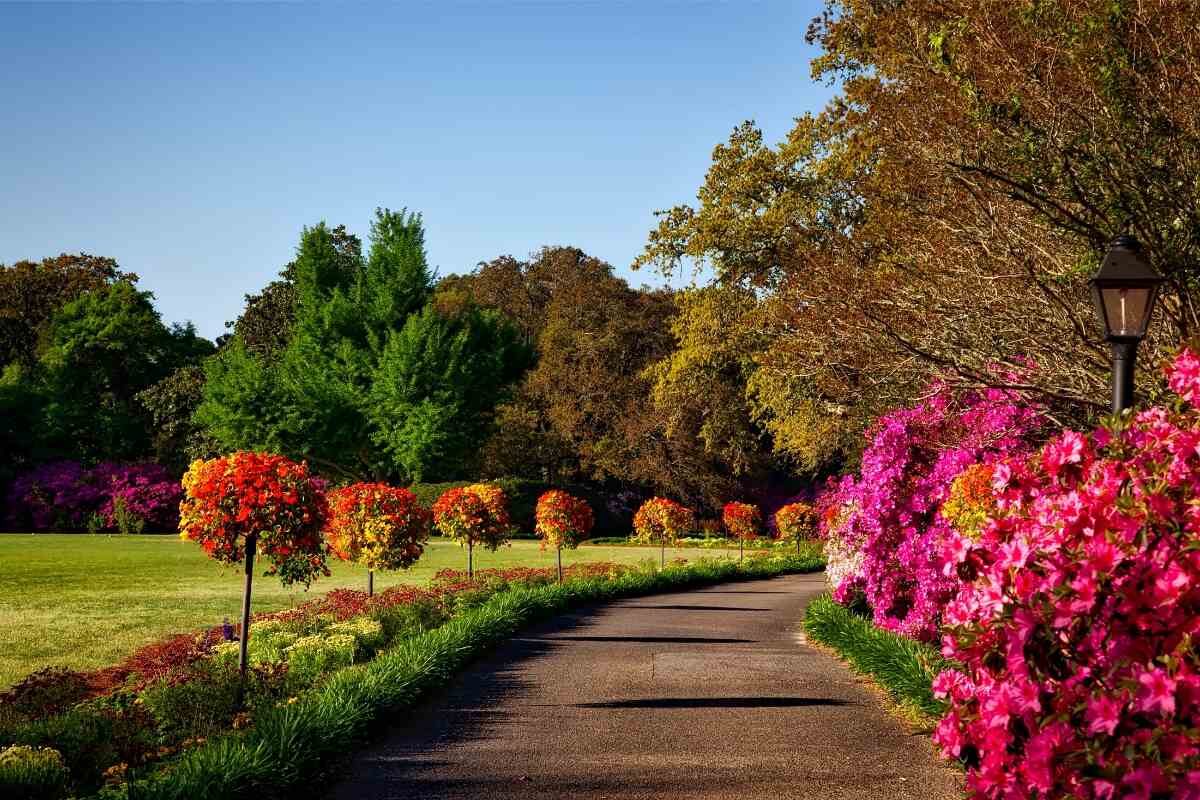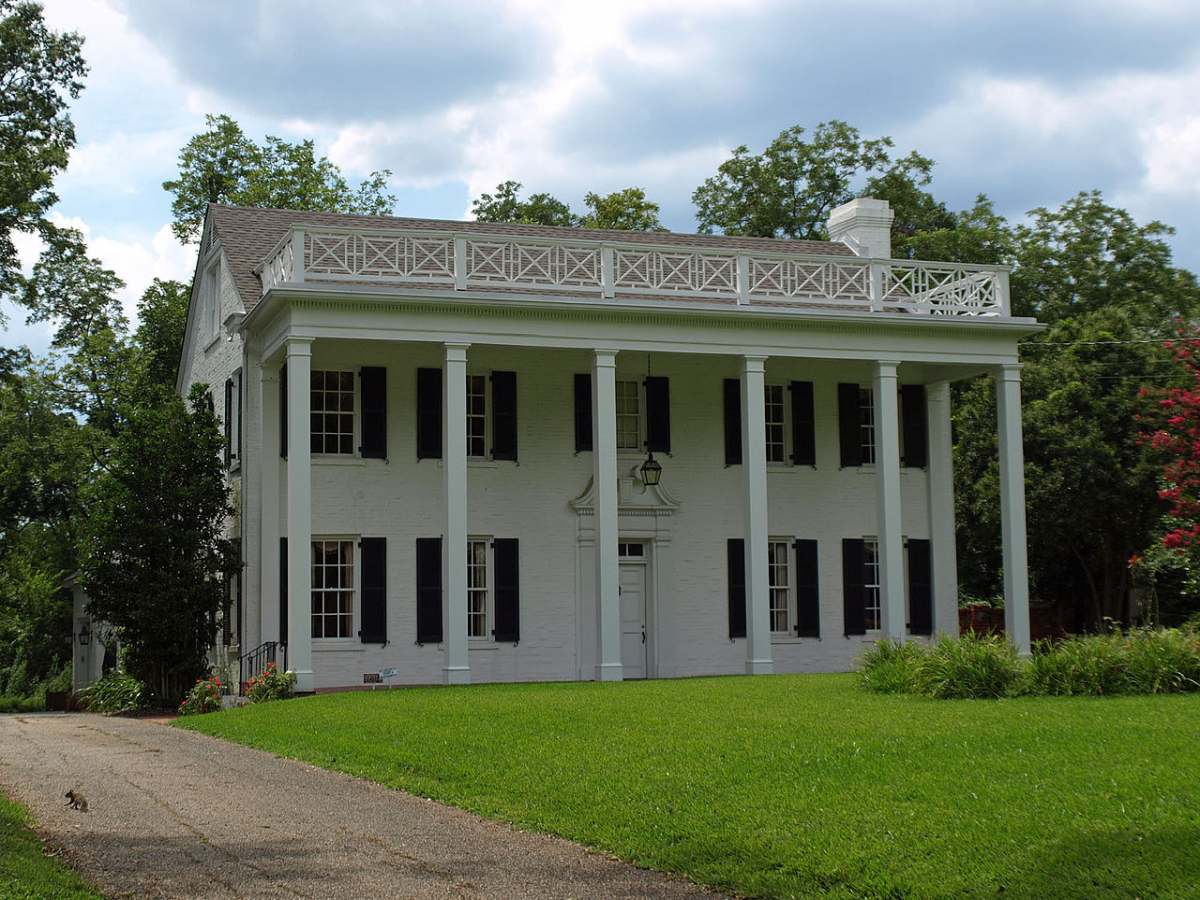
Alabamans know summer’s all about scorching temps and stifling humidity, but they experience various weather all year round. From bright, sunny days to torrential downpours, Alabamans have it all. With such varied conditions, you must carefully pick the best grass seed for Alabama so you can grow a lush, beautiful lawn no matter what the weather throws your way.
Let’s jump into the growing conditions and types of grass seed that are perfect for the Heart of Dixie.
Best Warm-Season Grasses for Alabama
For most of hot and humid Alabama, warm-season grasses are king. They’re resilient against heat and drought, so they come out strong in the summer. Usually, they go dormant in the cooler temperatures of spring and fall, and especially in winter, so they may not perform as well in the chillier Tennesee Valley region up north.
Wherever you live in Alabama, if you want a lawn that looks its best in the summertime, here are the best warm-season grass seeds for you to choose from:
Bermudagrass
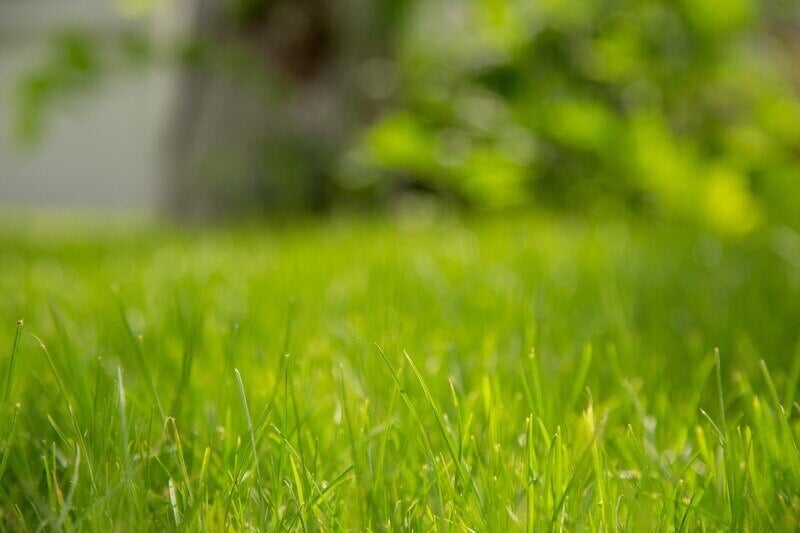
Photo Credit: rovenimages.com / Pexels
Bermudagrass loves Alabama’s warm days and is a ready-to-rumble option for homeowners across the state. This fast-growing grass stands up to hot temperatures, extreme humidity, and heavy foot traffic. It loves the sun and grows well in sandy soil, hence why it’s a common sight on golf courses.
On the downside, Bermudagrass won’t grow in the shade, so you must find other warm-season grasses for shadier spots. It also tends to develop an excessive layer of thatch because of its fast growth, so be prepared to dethatch your lawn regularly.
Pro Tip: Though Bermudagrass is the main choice for warm climates, Alabama’s northern regions may not be suitable. Northern Alabamans should consider Yukon Bermudagrass, which has superior cold tolerance. Otherwise, common Bermudagrass should be planted in central and southern Alabama, where it tends to thrive.
Main Characteristics:
- Classification: Warm-season grass
- Spreads by: Stolons and rhizomes
- Shade tolerance: Low shade tolerance; needs full sun exposure
- Drought tolerance: High
- Mowing height: Mow your Bermudagrass lawn between 0.5 and 1.5 inches for hybrid varieties or 1.5 to 2.5 inches for common Bermuda.
- Foot traffic tolerance: High
- Maintenance needs: Requires frequent mowing and dethatching because of aggressive growth
- Potential for disease: Good resistance to disease and insect pests
- Soil pH: 6-6.5
- Soil type: Adaptable to different soil types
Grass Seed Options:
– Scotts Turf Builder Bermudagrass (10-lb. bag)
– Hancock Seed Co. Bermudagrass (50-lb. bag)
Zoysiagrass
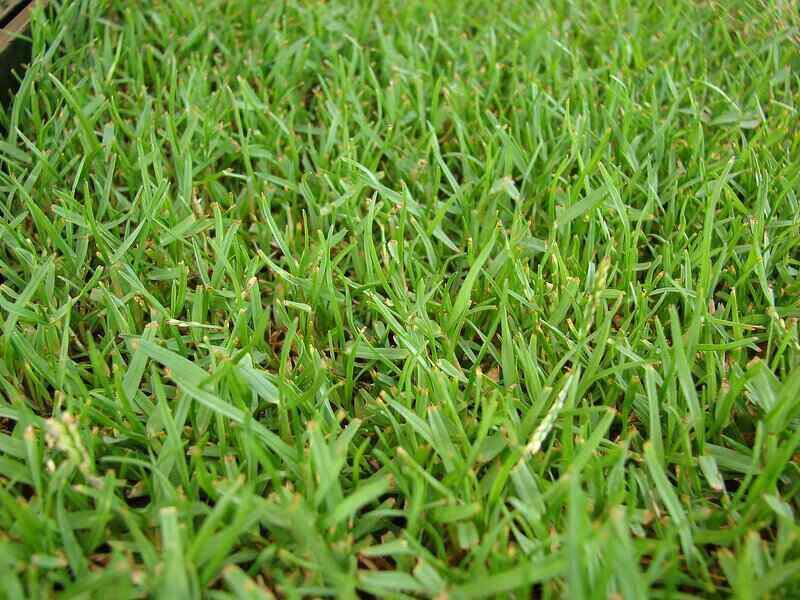
Photo Credit: Forest and Kim Starr / Wikimedia Commons / CC BY 3.0 US
This warm-season grass is super resilient and comes with moderate water needs. It loves the bright sunshine, and it’s perfect for both hot and humid climates (like the ones down south) and the colder temperatures in the north.
In Alabama, Zoysiagrass is one of the best sod choices around. It takes a while to bounce back from damage, but since it’s pretty slow-growing, mowings are few and far between. Generally speaking, you’ll need to cut it about once every two weeks. Keep in mind, though, that it’s harder to grow from seeds, so you may have to look into using grass plugs or sod.
The good thing is that Zoysiagrass can easily adapt to most soil types. Plus, it’s fairly resistant to disease. Still, remember that even though it’s drought-tolerant, regular watering is always recommended. Installing an irrigation system is a great idea if you don’t want to water manually. And if you don’t want thatch to build up, dethatching the lawn once a year is key.
Pro Tip: Setting your mowing height between one to two inches should do wonders for Zoysiagrass, and it usually doesn’t require a ton of fertilizer.
Main Characteristics:
- Classification: Warm-season grass
- Spreads by: Stolons and rhizomes
- Shade tolerance: Moderate
- Drought tolerance: Moderate to High
- Foot traffic tolerance: High, but recovers slowly from damage
- Maintenance needs: Low nitrogen fertilization requirements, although it’s prone to thatch build-up; slower growth means less frequent mowing
- Mowing height: Set mowing height between 1 and 2 inches.
- Potential for disease: Good disease tolerance overall
- Soil pH: 6-6.5
- Soil type: Needs well-draining soil; some cultivars are more tolerant of a wide range of soils than others.
Grass Plug and Seed Options:
– Zoysia Plugs (50 Large Grass Plugs)
– Zoysia Plugs (50 Full & Lush Grass Plugs)
– Zoysia Plugs (100 Plugs)
– Zenith Zoysia Grass Seeds (1/8 lb. of seeds)
Bahiagrass
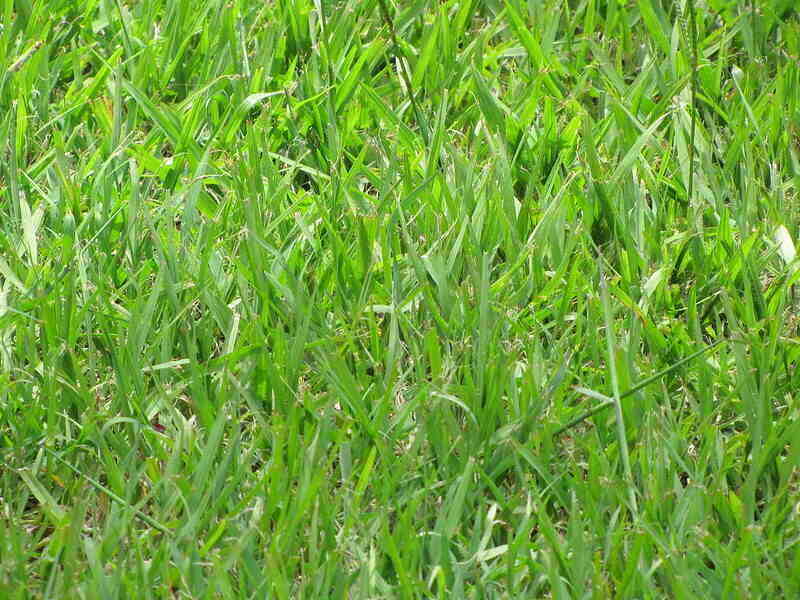
Photo Credit: Forest and Kim Starr / Flickr / CC BY 2.0
Alabama’s hot, humid climate makes it the perfect place for bahiagrass to flourish. This drought-resistant turfgrass is compatible with both acidic and sandy soils, so it easily takes root in your lawn. It sports a deep root system that spreads quickly and provides exceptional ground coverage.
However, you’ll need to mow bahiagrass frequently to keep it looking its best. Aim for a grass height of 3-4 inches, and make sure to remove the taller seed heads so they don’t take over. When it comes to bahiagrass varieties, Pensacola, Argentine, TifQuik, and UF Riata all work well for Alabama.
Bahiagrass is a hardy grass with unbeatable drought tolerance, but it can’t stand cold temperatures. So if you want to enjoy its lush, inviting grass for years to come, make sure you prepare the lawn for winter each year. That being said, bahiagrass isn’t a great option for North Alabama.
Main Characteristics:
- Classification: Warm-season grass
- Spreads by: Stolons
- Shade tolerance: Low, but more shade-tolerant than Bermudagrass.
- Drought tolerance: High
- Foot traffic tolerance: Low
- Maintenance needs: Low fertility requirements. Expect frequent mowing (every one to two weeks) to remove seed heads.
- Mowing height: Ideal grass height is 3 to 4 inches.
- Potential for disease: Good resistance to disease and insect infestations
- Soil pH: 5.5 to 6.5
- Soil type: Performs well in sandy loam soils, but tolerates a wide range of soils, including soils with low fertility.
- Varieties for Alabama: Pensacola, Argentine, TifQuik, UF Riata
Grass Seed Options
Pensacola Bahiagrass:
– SeedRanch Pensacola Bahiagrass Seed (10 lb. bag)
– Hancock Seed Co. Pensacola Bahiagrass Seed (5 lb. bag)
Argentine Bahiagrass:
– Scotts Turf Builder Argentine Bahiagrass (10 lb. bag)
– Hancock Seed Co. Argentine Bahiagrass Seed Mix (25 lb. bag)
Centipedegrass
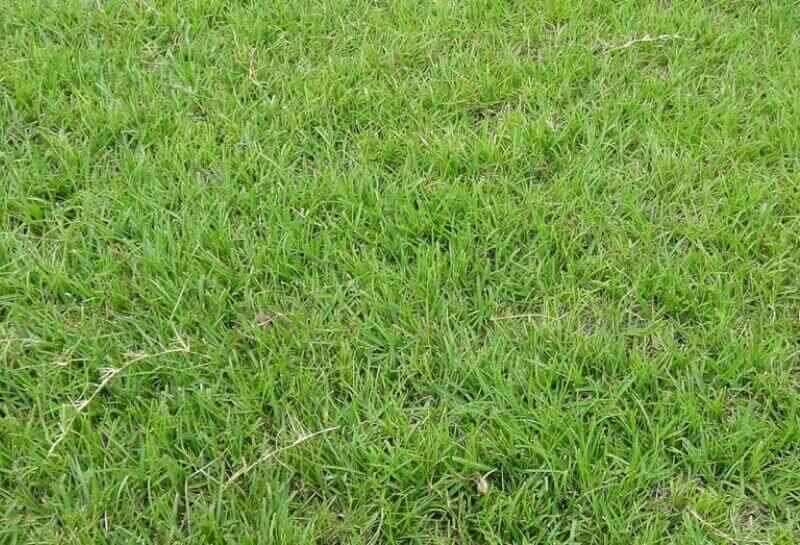
Photo credit: Michael Rivera / Wikimedia Commons / CC BY-SA 4.0
Alabama residents love the bright yellowish-green color and low-maintenance requirements of centipedegrass. Growing best in full sun, this grass can struggle if subjected to shade, drought, or heavy foot traffic. However, it spreads quickly and forms a thatch-less carpet that looks great and requires minimal effort.
Before planting, be sure to check your soil and climate. Centipedegrass thrives in the southeast and Gulf Coast but can struggle in colder, drier North Alabama weather. Also, be sure to follow a lawn care calendar that fits in with its peak growth time from spring to summer.
Pro Tips:
- Fertilize during early spring
- Prevent crabgrass and feed your lawn during February and May
- Check your soil pH level every 3-4 years
- Watch out for signs of pest infestation and lawn disease
- Avoid overseeding to protect the root system
Main Characteristics:
- Classification: Warm-season grass
- Spreads by: Stolons
- Shade tolerance: Moderate
- Drought tolerance: Low
- Foot traffic tolerance: Low
- Maintenance needs: Low fertilizer requirements. Requires weekly mowing.
- Mowing height: Set mowing height between 1 and 2 inches.
- Potential for disease: Common diseases include brown patch, leaf spot, and Pythium root rot.
- Soil pH: 5-6
- Soil type: Thrives in wet, poorly drained sandy soils with low fertility
Grass Seed Options:
– Gulf Kist Coated Centipedegrass Seeds (1 lb.)
– Scotts EZ Seed Patch and Repair Centipedegrass (3.75 lbs.)
– TifBlair Centipedegrass (5-lb. bag)
St. Augustinegrass
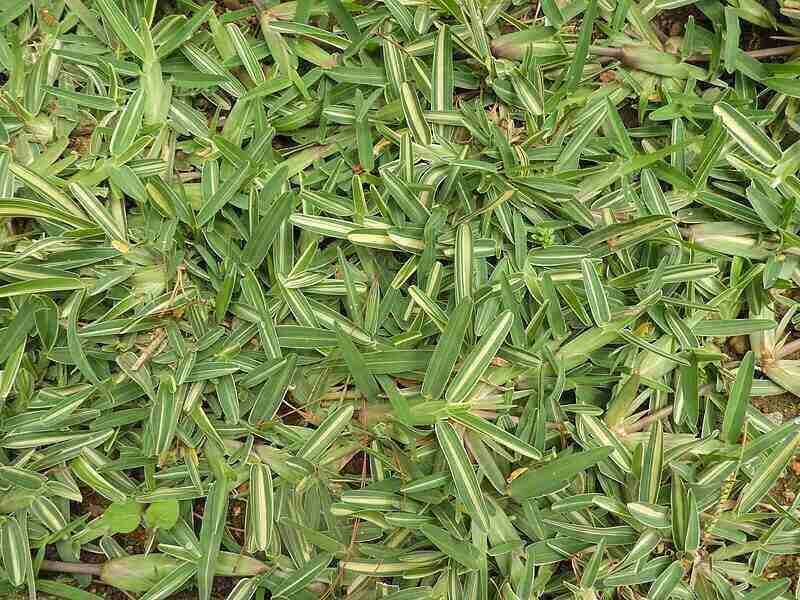
Photo Credit: Yercaud-elango / Wikimedia Commons / CC BY-SA 4.0
Not for the faint of heart, St. Augustinegrass is an enthusiastic turf that loves warmth and hates the cold. Growing quickly and spreading with ease, this turf easily takes over the Gulf Coast. It can even tolerate partial shade, although full sun is its favorite.
This warm-season grass is more resistant to sun and drought than many other lawn grasses commonly found in Alabama. When it’s established, it requires minimal water and absorbs nutrients easily.
However, this lawn grass is unsuitable for heavy foot traffic and is poor at recovering from excessive wear. To keep St. Augustinegrass healthy, make sure to mow between 3.5 to 4 inches, fertilize regularly, and use pest control as needed. Be sure to pay attention to soil pH levels and soil compaction. As you might have gathered, St. Augustinegrass is quite needy and high-maintenance if you want it to look its best.
A Word of Caution: St. Augustinegrass isn’t meant for the chilly winters of North Alabama, so keep that in mind before you sow a single seed.
Main Characteristics:
- Classification: Warm-season grass
- Spreads by: Stolons
- Shade tolerance: Moderate. It is the most shade-tolerant warm-season grass.
- Drought tolerance: Moderate to High
- Foot traffic tolerance: Low
- Maintenance needs: Needs frequent mowing due to fast growth rate; develops thatch easily; needs regular fertilization.
- Mowing height: Set the mowing height between 3.5 and 4 inches.
- Potential for disease: Moderate to high
- Soil pH: 6-7.5
- Soil type: Tolerates many soil types; prefers moderately fertile and moist (not waterlogged) soils; doesn’t tolerate soil compaction.
Grass Plug Options:
– Seed Ranch St Augustine Seville Grass Plugs (2 Trays)
– Seed Ranch St Augustine Floratam Grass Plugs (2 Trays)
Best Cool-Season Grasses for Alabama
Northern and north-central Alabama, from about Birmingham and up, falls in what’s called the transition zone, which means its climate is suitable for both warm-season and cool-season grass types. A mix of warm-season and cool-season grass seeds usually has the best year-round success in the transition zone.
That’s because, unlike the warm-season grasses listed above, cool-season grasses grow most actively in the cooler temperatures of spring and fall and struggle more during the hot summer. So, if you live north of Birmingham, consider the following grass types for a stunning green lawn in spring and fall:
Tall Fescue

Aaron J. Patton, Ph.D. / Turfgrass Extension Specialist at Purdue University
Fescue might not bring to mind images of the tropical south, but it does a great job of constructing a robust lawn in northern and north-central Alabama. It does best in the northernmost region of the state, around Decatur.
Because it’s a transitional grass, tall fescue can handle mild winters and hot summers with great success. However, it may be a bit weaker in terms of drought tolerance than some of its counterparts, especially during the most scorching part of summer.
Pro Tips:
- Homeowners in Alabama may consider mixing tall fescue with less cold-tolerant grasses like ryegrass to promote a greener and longer-lasting lawn.
- Tall fescue tends to bunch together, so you may want to overseed the lawn every 1-2 years to help get an even distribution.
Keep in mind that tall fescue may not be the best grass seed for Alabama’s extreme southern climates. The hot, humid summer months may put too much of a strain on this grass.
Main Characteristics:
- Classification: Cool-season grass
- Spreads by: Rhizomes and bunch-type growth
- Shade tolerance: Moderate
- Drought tolerance: Moderate to High
- Mowing height: Set mowing height to 2 inches when the grass reaches 3 inches tall
- Foot traffic tolerance: Moderate
- Maintenance needs: Frequent mowing and overseeding
- Potential for disease: Tolerant of most diseases when properly maintained
- Soil pH: 5.5-6.5
- Soil type: It loves a variety of soil conditions but is happiest with fertile clay soils and good drainage.
Grass Seed Options:
– Triple-Play Tall Fescue Grass Seed Blend (5000 sq ft)
– Eretz Kentucky 31 K31 Tall Fescue Grass Seed (choose your size)
– Pennington The Rebels Tall Fescue Grass Seed Mix (7 lb.)
Perennial Ryegrass
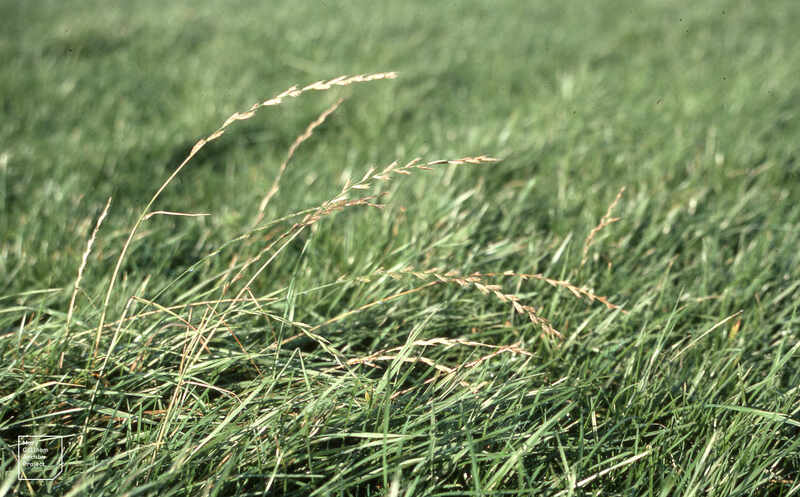
Photo Credit: Dr Mary Gillham Archive Project / Flickr / CC BY 2.0
Perennial ryegrass is perfect for Alabama’s humid climate and moist soil. This cool-season grass grows fast and fine so that you can count on a beautiful lawn in both full sun and partial shade areas.
It’s the perfect choice for winter overseeding in South Alabama, as it keeps its color in the cool months while warm-season grasses turn brown. Combining it with buffalograss is the way to go if you want color and texture all year round. Time your planting and overseeding to match local frost dates for the best results.
Once you have perennial ryegrass established in your lawn, make sure to stick with the recommended lawn care schedule for Alabama. That includes regularly mowing to 1.5 to 2.5 inches, fertilizing from March to May, checking the soil pH every few years, watering only as needed, and controlling pests in late spring.
Main Characteristics:
- Classification: Cool-season grass
- Spreads by: Bunch-type growth habit
- Shade tolerance: Low
- Drought tolerance: Low
- Foot traffic tolerance: High
- Maintenance needs: Moderate mowing and fertilization requirements. Thatch is not significant.
- Mowing height: Set mowing height to 1.5 to 2.5 inches
- Potential for disease: High. Common diseases include gray leaf spot, red thread, and leaf spot/melting-out.
- Soil pH: Can grow in soils with a pH between 5 and 8, but prefers between 6 and 7.
- Soil type: Prefers good drainage and fertility, but can tolerate some poor drainage.
Grass Seed Options:
– Outsidepride Perennial Ryegrass Seed (5 lbs.)
– Eretz ProTurf Perennial Ryegrass Fine Lawn Seed (choose your size)
Kentucky Bluegrass

Photo Credit: Shutterstock
It’s impossible to talk about lawn grasses without mentioning Kentucky bluegrass. This resilient cool-season grass is well adapted to the northernmost parts of Alabama, where winters are a little chillier. Primarily found on athletic fields, golf courses, and parks, this grass is dark green and has a fine texture.
When properly maintained, Kentucky bluegrass has excellent wear tolerance. It spreads through rhizomes and is moderately tolerant to both shade and drought. To keep this turfgrass in good condition, you’ll need to mow your lawn regularly, fertilize it properly, and be aware of potential disease threats.
The ideal mowing height for this grass is between 2.5 and 3.5 inches, and it’s best planted in well-drained, high-fertility soils with a pH of 6-7.5.
Note: Kentucky bluegrass is not recommended for use anywhere in Alabama except the extreme north, around Decatur and up.
Main Characteristics:
- Classification: Cool-season grass
- Spreads by: Rhizomes
- Shade tolerance: Moderate
- Drought tolerance: Moderate
- Foot traffic tolerance: Moderate
- Maintenance needs: Moderate mowing frequency and high fertilization needs.
- Mowing height: Set mowing height between 2.5 and 3.5 inches.
- Potential for disease: Moderate to high; prone to several diseases, such as dollar spot, leaf spot, necrotic ring spot, summer patch, and stripe smut.
- Soil pH: 6-7.5
- Soil type: Performs best in well-drained, heavy soils with high fertility.
Grass Seed Options:
– Jonathan Green (11970) Blue Panther Kentucky Bluegrass Grass Seed (3 lbs.)
– SeedRanch Midnight Kentucky Bluegrass Seed (5 lbs.)
Best Grass for North Alabama
In North Alabama, temperatures can dip to an icy 19 degrees Fahrenheit, making it much chillier than other parts of the South. The best grass types for Huntsville, Decatur, Florence-Muscle Shoals, Fort Payne, and other cities in the Tennessee Valley region have to be able to tolerate cold temperatures.
While some warm-season grasses can survive North Alabama winters, cool-season grasses are generally a better bet. However, your grass still needs to be able to survive a hot, dry summer.
For a successful lawn in North Alabama, try either a combination of warm-season and cool-season grass seeds or just a cool-season grass that’s up to the task.
Here are the best grasses for North Alabama:
- Tall fescue
- Yukon Bermudagrass
- Zoysiagrass
- Perennial ryegrass
- Kentucky bluegrass
Best Grass for Central Alabama
Thanks to its moderate climate, Central Alabama is an excellent place for grass seeding because most grass types can thrive there. The best grass types for Birmingham, Tuscaloosa, and other north-central cities include both cool-season and warm-season grasses.
A little further south, in places like Montgomery and Auburn, warm-season grasses will be your best bet.
Central Alabama homeowners should consider these grass types:
- Bermudagrass
- Zoysiagrass
- Centipedegrass
- Tall fescue (north-central only)
Best Grass for South Alabama
You can thank South Alabama’s tropical Gulf Coast air and bountiful summer warmth for its lush, green lawns. Home to the bustling Mobile and Baldwin counties, this part of Alabama enjoys hot days and mild winters. That’s why you’ll see plenty of warm-season grasses thriving across the region and no cool-season grasses.
If you’re looking for the perfect lawn seed for South Alabama, look no further than:
- Bermudagrass
- Zoysiagrass
- Bahiagrass
- Centipedegrass
- St. Augustinegrass
These grasses stand up to the scorching summer and pride themselves on their good looks.
Alabama Climate and Soil Conditions for Grass Growth
Alabama’s six distinct ecoregions mean temperatures and precipitation can vary widely across the state. In the North, you’ve got loamy and clay soils, while the central and coastal regions tend to be sandier.
Plus, the average temp is a temperate 64 degrees Fahrenheit, with highs reaching 79 degrees Fahrenheit and lows hitting around 19 degrees Fahrenheit. On top of that, you’ll get 52 to 64 inches of rainfall annually across Alabama, with the north getting less than the south. That’s a lot of variation, which is why it’s so important to choose the best grass type for your specific region of Alabama.
Another challenge for Alabama lawns is an abundance of weeds. Learn to identify Alabama’s most common weeds so you can get rid of them as soon as you spot them amidst your grass.
Alabama’s USDA Hardiness Zone
With all this in mind, it’s no surprise that Alabama’s USDA Hardiness Zones fall between 7a to 9b, making most grasses suitable for the region. Just remember that some grasses struggle in the higher temperatures and humidity of the south, while others may not make it through the cold winters in the north.
FAQ About Alabama Grass Types
In Alabama, you’ll find a variety of grasses, but none beat Bermuda for its sunny-weather suitability. In the northern half of the state, turf-type fescue’s shade tolerance makes it a great choice. But when it comes to areas of the state where full sun is frequently enjoyed, Bermuda is the way to go.
Even better, you can overseed Bermuda with ryegrass in the winter to add a splash of vibrancy when the warm-season grass goes dormant.
It’s tough to say what’s the fastest-growing grass seed in Alabama, but there are a few popular options. Plenty of folks opt for Bermudagrass, which grows quickly and is resilient in hot, humid climates. However, perennial ryegrass grows faster than Bermuda and resists mild drought, although it’s not as heat-tolerant.
The best time to plant grass seed in Alabama is typically in the early spring, from mid-February to mid-March. This helps ensure the seeds get enough sun and ample moisture to sprout and grow, as they need both to get established. Just be sure to take a look at the weather forecast, as it’s important to avoid cold snaps and frost.
Planting a little later, around April or May, can still be successful, too — you just want to make sure you provide enough water to help the seedlings through the warmer temperatures.
Fall is another great time of year to plant grass seed in Alabama if you’re in the north and looking to establish a cool-season grass type like rye or fescue. Planting in September or October ensures that the roots have time to grow before cold weather sets in, giving your grass the best chance for success in the upcoming season.
The most drought-tolerant grass for Alabama lawns is Bermudagrass. It’s a hardy variety that can withstand long periods of dry weather and high temperatures, making it an ideal choice for yards in the Yellowhammer State. It also has a fairly quick growth rate, so you won’t have to wait long for a healthy lawn.
Northern Alabama can be challenging for grasses, being in the transition zone. Depending on your exact location, the best types of grass vary. For instance, if you live in Birmingham or the surrounding areas, you may opt for the following: Bermudagrass, Zoysiagrass, tall fescue, or Bahiagrass.
On the other hand, if you live way up north near Huntsville, you can go for these grasses as well as Kentucky bluegrass.
Aside from grass, the best things to plant in your landscape are Alabama native plants, which are lower maintenance than non-natives and benefit local wildlife. There are tons of beautiful flowers, trees, shrubs, and more to choose from!
When to Hire a Lawn Care Pro
Alabamans are no strangers to varied climates and soil conditions. But when it comes to gardening, you need to pick the grass that fits your specific needs. If you choose the perfect grass type for your region, you’ll have a lawn to be proud of.
But the work doesn’t end when you plant the grass. Regular mowing, fertilization, weed control, and more are necessary if you want your lawn to stay lush and beautiful. Whenever you need help with lawn care – whether you’re in Montgomery, Birmingham, Huntsville, Mobile, or anywhere else in Alabama – LawnStarter can connect you with the best local lawn care pros to get the job done right.
Main Image Credit: Chris Pruitt / Wikimedia Commons / CC BY-SA 3.0
